
German postcard by Ross Verlag, no. 3738/2, 1928-1929. Photo: Atelier Balázs, Berlin.
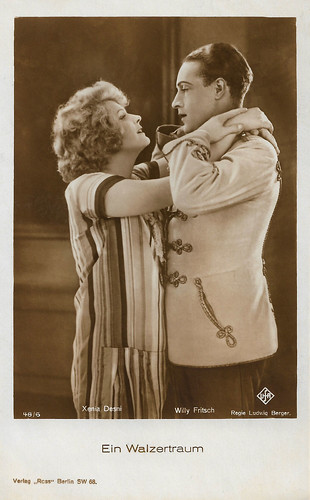
German postcard by Ross Verlag, no. 48/6. Photo: Ufa. Xenia Desni and Willy Fritsch in Ein Walzertraum/The Waltz Dream (Ludwig Berger, 1925), adapted from the Oscar Straus operetta.

German postcard by Ross Verlag, Berlin, no. 1026/1, 1927-1928. Photo: Ufa. Xenia Desni in Die gefundene Braut/The Found Bride (Rochus Gliese, 1925).
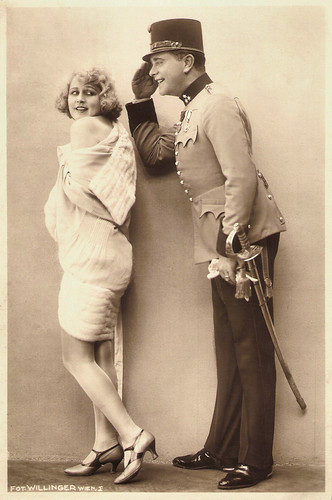
Austrian photo by Willinger, Wien. Xenia Desni and Livio Pavanelli in the German silent film Die letzte Einquartierung aka Küssen ist keine Sünd'/Kissing is no sin (Rudolf Walther-Fein, Rudolf Dworsky, 1926). A gift from their niece Tatiana.

Austrian postcard by Iris Verlag, no. 669/1. Photo: Naxos-Film / Verleih E. Weil & Co. Xenia Desni in the comedy Nixchen (Curt Blachnitzky, 1926).

German postcard by Ross Verlag, no. 3760/1, 1928-1929. Photo: Alex Binder, Berlin.
A successful but short film career in Berlin
Xenia Desni (Ukrainian: Ксенія Десні) was born Ksenia Desnytska in 1894 in the town of Oster near Kyiv, then part of the Russian Empire and now Ukraine. Her artistic talent was evident from an early age, and her passion for dance in particular was supported and encouraged by her parents. In 1911 she gave birth to her daughter, the future stage and film actress of the 1930s and 1950s, Tamara Desni. During the turmoil of the First World War and the Russian Revolution, Desni and her family fled to Constantinople (now Istanbul) where she worked as a variety dancer.
She travelled to Berlin where she had a successful but short film career in the 1920s. Several sources claim that she made her film debut with Sappho (Dimitri Buchowetzki, 1921) starring Pola Negri, but there is no evidence of this. Desni's name first appeared in 1921 in the credits of Weib und Palette/The Call of Fate (1921), directed by Johannes Guter, who later cast her in many of his films.
Their next film was Die Schwarze Pantherin/The Black Panther (Johannes Guter, 1921) starring Yelena Polevitskaya and produced by Erich Pommer. The film was produced by Russo Film, a small production outfit associated with Decla-Bioscop, which had been set up to produce films based on literature. Die Schwarze Pantherin/The Black Panther was adapted from a play by Volodymyr Vynnychenko, a Ukrainian statesman, political activist, writer, playwright and artist who served as the first prime minister of the Ukrainian People's Republic. Xenia signed a contract with the Ufa.
With Guter she worked on such films as Bardame/Barmaid (1922) with Paul Hartmann, Der Ruf des Schicksals/The Call of Destiny (Johannes Guter, 1922) with Fritz Kortner and Ernst Hofmann, Die Prinzessin Suwarin/Princess Suwarin (Johannes Guter, 1923) starring Lil Dagover and based on the novel by Ludwig Wolff, which had previously appeared in the Berliner Illustrierte Zeitung. She played Hedwig Tell the wife of the title figure in Wilhelm Tell (Rudolf Dworsky, Rudolf Walther-Fein, 1923). The film portrays the story of the legendary Swiss national hero William Tell. Other successful productions were Die Andere/The Other Woman (Gerhard Lamprecht, 1924), Der Sprung ins Leben (Johannes Guter, 1924) and the German-British costume film Dekameron-Nächte/Decameron Nights (Herbert Wilcox, 1924) based on two stories from the 'Decameron' by Giovanni Boccaccio with Lionel Barrymore as Prince Saladin. It was followed by Der Turm des Schweigens/The Tower of Silence (Johannes Guter, 1925) based on the play 'The Tempest' by William Shakespeare. Many films by Johannes Guter are considered lost, but this film was restored by the Friedrich Wilhelm Murnau Foundation in 2006 and was screened at the Berlin International Film Festival in 2007.
Desni played the beautiful violinist/conductor Franzi Steingruber alongside Mady Christians (Princess Alix von Flausenthurn) and Willy Fritsch (Prince Consort Nikolaus Count Preyn) in Ein Walzertraum/A Waltz Dream (Ludwig Berger, 1925). Ein Walzertraum was based on the 1907 operetta 'Ein Walzertraum' composed by Oscar Straus. At first, Berger had not wanted to film Straus' operetta because an operetta as a silent film seemed an absurd idea to him. Stephanie D'heil at Steffi-Line: "But then he realised: 'Here is new territory! Silent film from the spirit of music. Melody in every face, rhythm in every movement and shot. This is the only way to artistically realise the banal story of a puritanically educated princess who learns from a violinist how to make her husband happy. With actors who first have to be "renovated". Berger becomes an obsessive, a tamer. He transforms the elegiac Russian Xenia Desny into a lively personality." Ein Walzertraum/A Waltz Dream became a worldwide success. Unlike many of Ufa's ambitious productions of the 1920s, Ein Walzertraum managed to recover its production cost in the domestic market alone and was influential in the development of later Viennese operetta films.

German postcard by Ross Verlag, no. 571/1, 1919-1924. Photo: A. Eberth, Berlin.
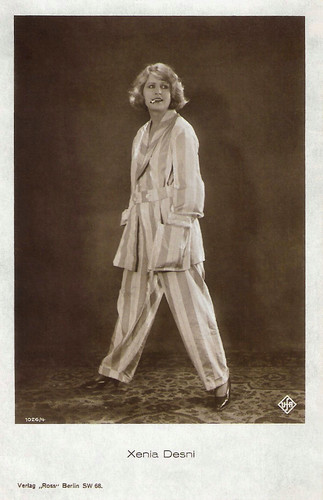
German postcard by Ross Verlag, no. 1026/4, 1927-1928. Photo: Ufa. Xenia Desni in Die gefundene Braut/The Found Bride (Rochus Gliese, 1925). From Tatiana.
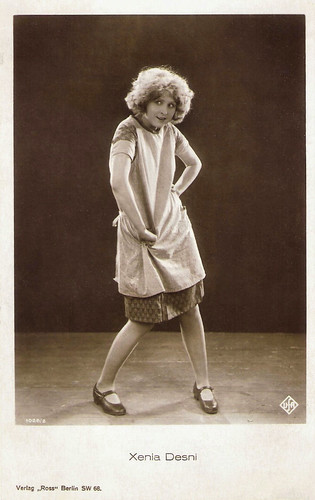
German postcard by Ross Verlag, no. 1028/2, 1927-1928. Photo: Ufa. From Tatiana.

German postcard by Ross Verlag, no. 1788/2, 1927-1928. Photo: Alex Binder, Berlin.
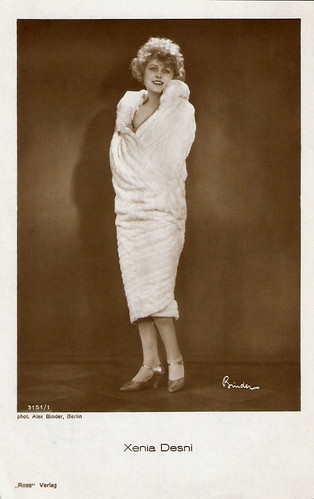
German postcard by Ross Verlag, no. 3151/1, 1928-1929. Photo: Alex Binder, Berlin.
Managing her daughter
Xenia Desni's film career flourished in the years 1926-1927. She made one film after another, including Der rosa Diamant/The Pink Diamond (Rochus Gliese, 1926) with Rudolf Klein-Rogge, the comedy Familie Schimeck/The Schimeck Family (Alfred Halm, Rudolf Dworsky, 1926) with Livio Pavanelli and Max Hansen, and Madame wagt einen Seitensprung (Hans Otto, 1927). With Harry Liedtke and Hans Albers, she co-starred in the cheerful Nixchen (1926) based on the novel by Helene Keßler alias Hans von Kahlenberg. She reunited with Willy Fritsch for Die Boxerbraut/The Boxer's Bride (Johannes Guter, 1926).
In France, she appeared with Louise Lagrange and Ricardo Cortez in the silent drama La danseuse Orchidée/The Orchid Dancer (Léonce Perret, 1928). It was shot at the Victorine Studios in Nice. Her last silent film was the Austrian historical drama Erzherzog Johann/Archduke John (Max Neufeld, 1929) starring Igo Sym as Archduke John of Austria, a nineteenth-century member of the Habsburg Dynasty. After the advent of sound film, Xenia Desni's screen career came to an end, probably due to a lack of voice technique.
Between 1924 and 1926, Xenia Desni had a summer residence built in Bansin, which she lived in with her daughter for several years until the house became the property of the industrial magnate Gerdes. According to IMDb and English Wikipedia, she appeared in one more film, the German crime film Kriminalkommissar Eyck (Milo Harbich, 1940) starring Anneliese Uhlig and Paul Klinger.
Her daughter Tamara Desni (1911-2008) acted in a half dozen German sound films. In 1931, Xenia and Tamara settled in London. There Tamara worked for decades as an actress in the British film industry. She was married to Canadian actor Raymond Lovell (1900-1953).
In 1950, Tamara moved with Lovell to France. In 1956, she and her fifth husband, Albert Lavagna, opened a successful hotel and restaurant, L'Auberge Chez Tamara, on the Cote d'Azur in Grasse. Xenia eventually moved in with them. Xenia Desni died in 1962 in Roquefort-les-Pins on the Côte d'Azur. She was 68.

German photo by Ufa.

Vintage photo. Xenia Desni and her daughter Tamara having fun at the beach, in the early 1920s. From Tatiana.

German postcard by Ross Verlag, no. 48/4. Photo: Ufa. Xenia Desni in Ein Walzertraum/The Waltz Dream (Ludwig Berger, 1925), based on the Oscar Straus operetta.

Austrian postcard by Iris Verlag, no. 513/1. Photo: Sascha.

Austrian postcard by Iris Verlag, no. 670/1. Photo: Naxos-Film / Austrian distr. E. Weil. Hans Albers and Xenia Desni in Nixchen (Kurt Blachnitzky, 1926).

Austrian postcard by Iris Verlag, no. 669/2. Photo: Naxos-Film / distr. E. Weil & Co. Probably also a postcard for the German silent film comedy Nixchen (Curt Blachnitzky, 1926), as this was Naxos' only production with Desni.
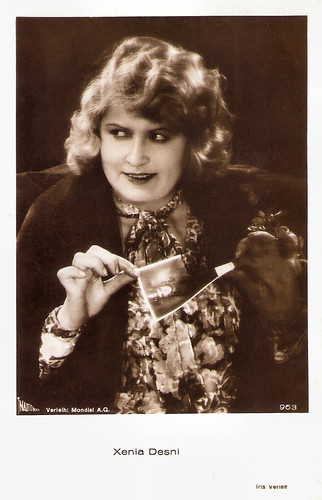
Austrian postcard by Iris Verlag, no. 963. Photo: National Film. / Distr. Mondial A.G. Probably a card for the National Film production Die Bräutigame der Babette Bomberling/The Grooms of Babette Bomberling (Viktor Janson, 1927).

Austrian postcard by Iris Verlag, no. 5014. Photo: National Film / Verleih Mondial-Film. Xenia Desni in the National Film production Die Bräutigame der Babette Bomberling/The Grooms of Babette Bomberling (Vikor Janson, 1927). N.B. Walter Rilla does not act in this film so the actor is probably Egon von Jordan.
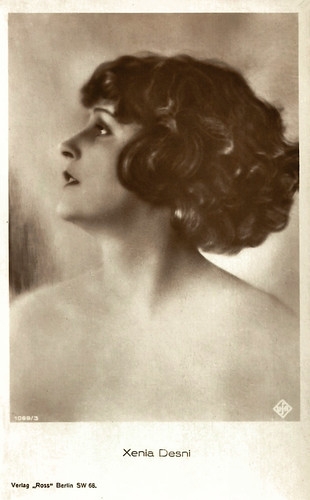
German postcard by Ross Verlag, Berlin, no. 1069/3, 1927-1928. Photo: Ufa.
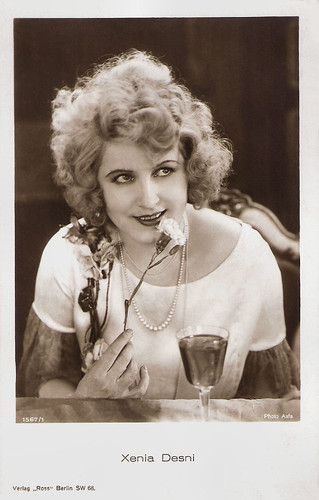
German postcard by Ross Verlag. Berlin, no. 1567/1, 1927-1928. Photo: Aafa.
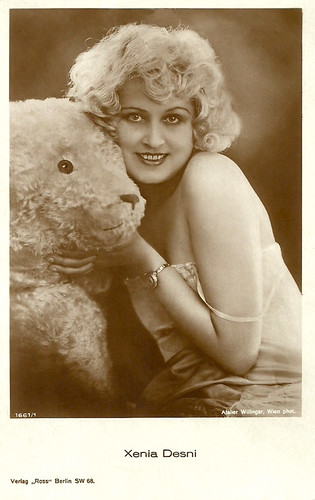
German postcard by Ross Verlag, Berlin, no. 1661/1, 1927-1928. Photo: Atelier Willinger, Wien.
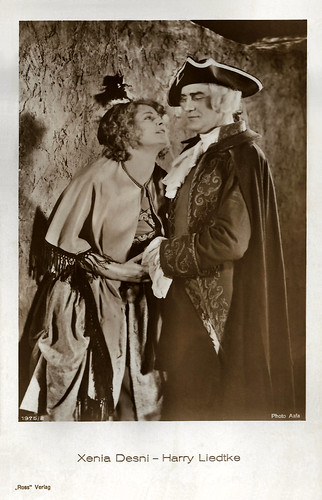
German postcard by Ross Verlag, no. 1975/2, 1927-1928. Photo: Aafa. Xenia Desni and Harry Liedtke in Ein Mädel aus dem Volke/A girl from the people (Jacob Fleck, Luise Fleck, 1927).

German postcard by Ross Verlag, no. 4454/1, 1929-1930. Photo: Atelier Balázs, Berlin.
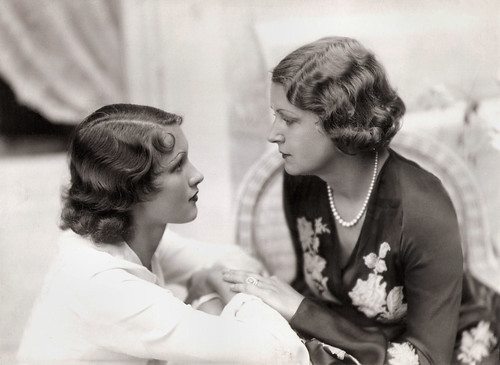
Vintage photo of Tamara and Xenia Desni. From Tatiana.
Source: Stephanie D'heil (Steffi-Line - German), Thomas Staedeli (Cyranos), Find A Grave, Wikipedia (English, Ukranian and German) and IMDb.
3 comments:
If anybody is interested in additional photos of Tamara and Xenia Desni, please contact Tatiana at tanyabeh87@gmail.com
I looking for relatives Tamara Desni.
Please, write me:
Kostyagina@gmail.com
@ Kostyagina@gmail.com:
Sorry, but we can't help you.
Paul van Yperen, editor EFSP.
Post a Comment